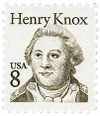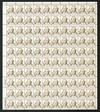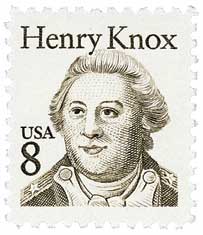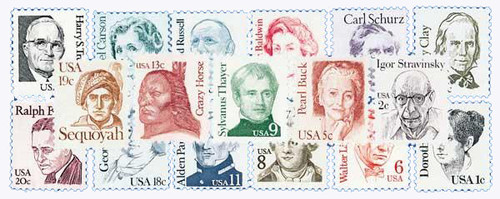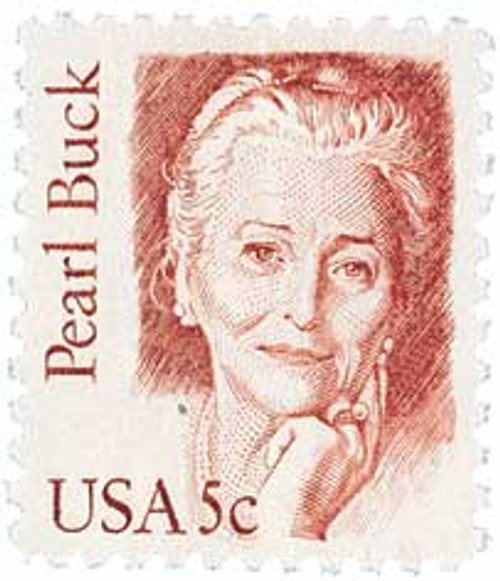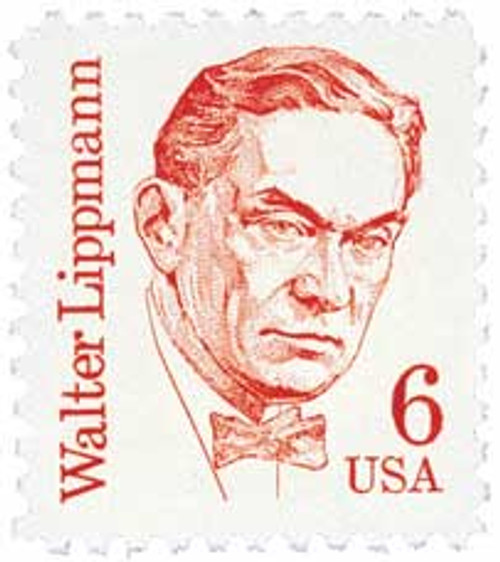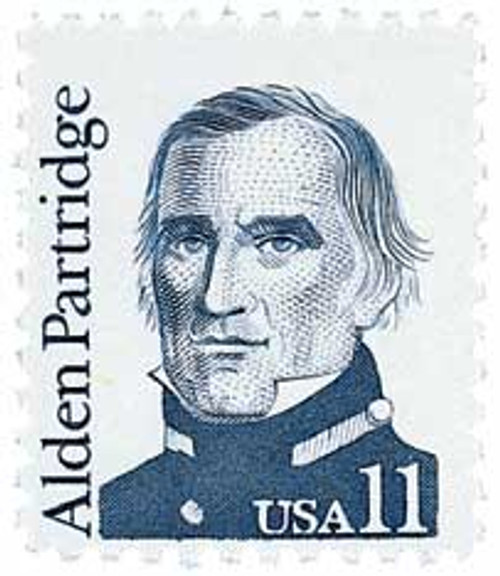
# 1851 - 1985 8c Great Americans: Henry Knox
1985 8¢ Henry Knox
Great Americans Series
City: Thomaston, Maine
Quantity: 60,950,000
Birth Of Henry Knox
After his father abandoned the family, Henry, the family’s oldest son, left school and took a job as a clerk in a bookstore. The shop’s owner, Nicholas Bowes, became a father figure to Knox. But Knox was also caught up in Boston’s street gangs, becoming one of his neighborhood’s best fighters. Then, one day he witnessed an impressive military demonstration and decided to join his local artillery company at age 18.
In 1770, Knox witnessed the Boston Massacre, though he had tried to end it peacefully. The following year, he opened his own bookshop, the London Book Store. Having had little education as a child, Knox used his store to teach himself a number of things. He soon developed a deep interest in military history, reading everything he could find about military subjects.
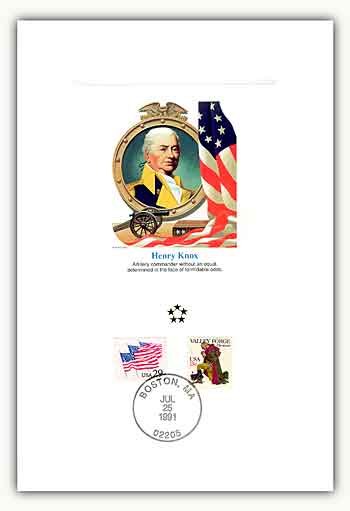
In 1772, he cofounded the Boston Grenadier Corps, which he served as second in command. During this time, Knox supported the actions of the Sons of Liberty. While it’s unknown if he participated in the Boston Tea Party, he did serve as a guard for one of the ships, ensuring the tea wasn’t unloaded before the uprising.
Knox married Lucy Flucker in 1774, the daughter of Boston Loyalists who attempted to get Knox on their side. When the Battles of Lexington and Concord broke out the following year, Knox and his wife snuck out of Boston. Knox then joined the local militia in besieging the city. His bookshop was looted and all the stock was either destroyed or stolen. Working under General Artemas Ward, Knox developed fortifications for the city and then oversaw the artillery fire at the Battle of Bunker Hill.
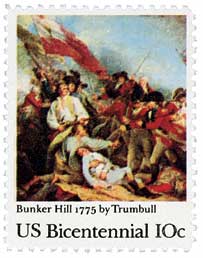
General George Washington arrived in July 1775 to assume command of the army and was impressed by Knox’s work. The two men became good friends and worked together to develop the Continental Army. Knox hadn’t received an official military commission, but John Adams convinced the Second Continental Congress to appoint him a colonel in the army’s artillery regiment.
While Boston was still under siege, Knox had an idea. If they could get the cannons from recently captured Forts Ticonderoga and Crown Point to Boston, they could turn the tide of the battle. Washington supported his idea and sent him on the mission, which became known as Knox’s “noble train of artillery.” Knox and a team of engineers transported 60 tons of artillery from Northern New York to Boston in the middle of winter. One historian called the move, “one of the most stupendous feats of logistics” of the war. With those cannons in place, Washington forced the British to surrender the city.
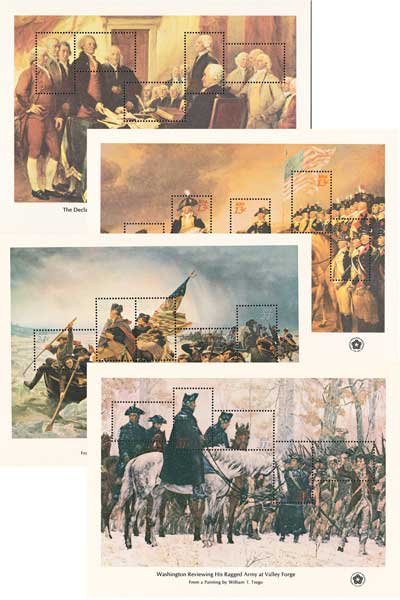
As Washington’s right-hand man, Knox joined the commander-in-chief on most of his campaigns and was involved in most of the war’s major battles. He was nearly captured after the British invaded Manhattan. In December 1776, Knox directed the Christmas night crossing of the Delaware River that preceded the Battle of Trenton. He then oversaw the return of those men and hundreds of prisoners. For his efforts, Knox was promoted to brigadier general and given command of five artillery regiments.
That winter, Knox went back to Massachusetts to improve the manufacture of artillery and raise another battalion. He went on to participate in the battles at Brandywine, Germantown, and Monmouth before forming the army’s first artillery and officer training school which is often considered the precursor to West Point. He then joined in the Siege of Yorktown, where he directed artillery. In 1782, Knox became the army’s youngest major general and was tasked with negotiating prisoner exchanges with the British, which ultimately failed. When Washington stepped down in 1783, Knox took over as the senior commander of the Army. He formed the Society of the Cincinnati, a fraternity of Revolutionary War officers, and developed plans for a peacetime army.
1985 8¢ Henry Knox
Great Americans Series
City: Thomaston, Maine
Quantity: 60,950,000
Birth Of Henry Knox
After his father abandoned the family, Henry, the family’s oldest son, left school and took a job as a clerk in a bookstore. The shop’s owner, Nicholas Bowes, became a father figure to Knox. But Knox was also caught up in Boston’s street gangs, becoming one of his neighborhood’s best fighters. Then, one day he witnessed an impressive military demonstration and decided to join his local artillery company at age 18.
In 1770, Knox witnessed the Boston Massacre, though he had tried to end it peacefully. The following year, he opened his own bookshop, the London Book Store. Having had little education as a child, Knox used his store to teach himself a number of things. He soon developed a deep interest in military history, reading everything he could find about military subjects.

In 1772, he cofounded the Boston Grenadier Corps, which he served as second in command. During this time, Knox supported the actions of the Sons of Liberty. While it’s unknown if he participated in the Boston Tea Party, he did serve as a guard for one of the ships, ensuring the tea wasn’t unloaded before the uprising.
Knox married Lucy Flucker in 1774, the daughter of Boston Loyalists who attempted to get Knox on their side. When the Battles of Lexington and Concord broke out the following year, Knox and his wife snuck out of Boston. Knox then joined the local militia in besieging the city. His bookshop was looted and all the stock was either destroyed or stolen. Working under General Artemas Ward, Knox developed fortifications for the city and then oversaw the artillery fire at the Battle of Bunker Hill.

General George Washington arrived in July 1775 to assume command of the army and was impressed by Knox’s work. The two men became good friends and worked together to develop the Continental Army. Knox hadn’t received an official military commission, but John Adams convinced the Second Continental Congress to appoint him a colonel in the army’s artillery regiment.
While Boston was still under siege, Knox had an idea. If they could get the cannons from recently captured Forts Ticonderoga and Crown Point to Boston, they could turn the tide of the battle. Washington supported his idea and sent him on the mission, which became known as Knox’s “noble train of artillery.” Knox and a team of engineers transported 60 tons of artillery from Northern New York to Boston in the middle of winter. One historian called the move, “one of the most stupendous feats of logistics” of the war. With those cannons in place, Washington forced the British to surrender the city.

As Washington’s right-hand man, Knox joined the commander-in-chief on most of his campaigns and was involved in most of the war’s major battles. He was nearly captured after the British invaded Manhattan. In December 1776, Knox directed the Christmas night crossing of the Delaware River that preceded the Battle of Trenton. He then oversaw the return of those men and hundreds of prisoners. For his efforts, Knox was promoted to brigadier general and given command of five artillery regiments.
That winter, Knox went back to Massachusetts to improve the manufacture of artillery and raise another battalion. He went on to participate in the battles at Brandywine, Germantown, and Monmouth before forming the army’s first artillery and officer training school which is often considered the precursor to West Point. He then joined in the Siege of Yorktown, where he directed artillery. In 1782, Knox became the army’s youngest major general and was tasked with negotiating prisoner exchanges with the British, which ultimately failed. When Washington stepped down in 1783, Knox took over as the senior commander of the Army. He formed the Society of the Cincinnati, a fraternity of Revolutionary War officers, and developed plans for a peacetime army.






